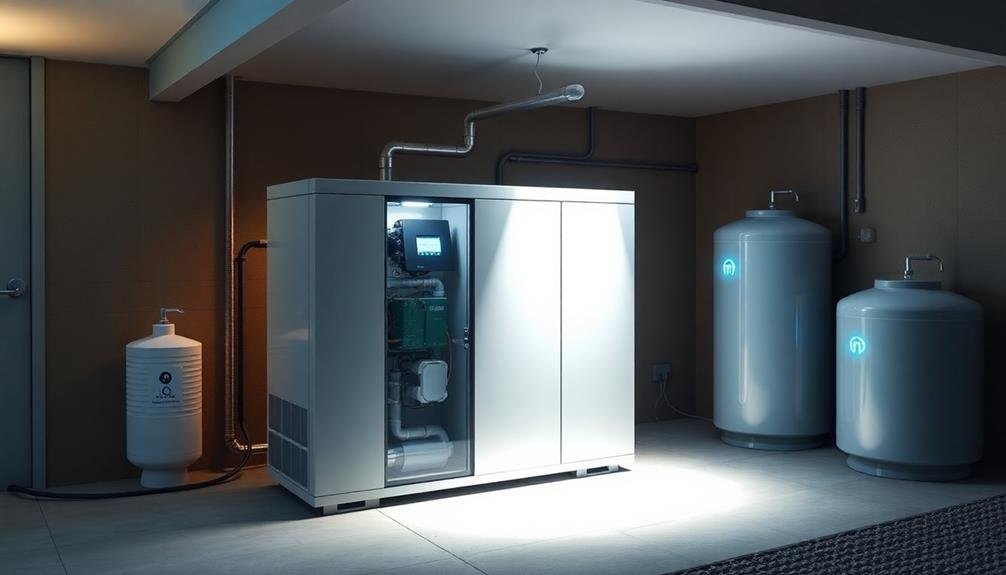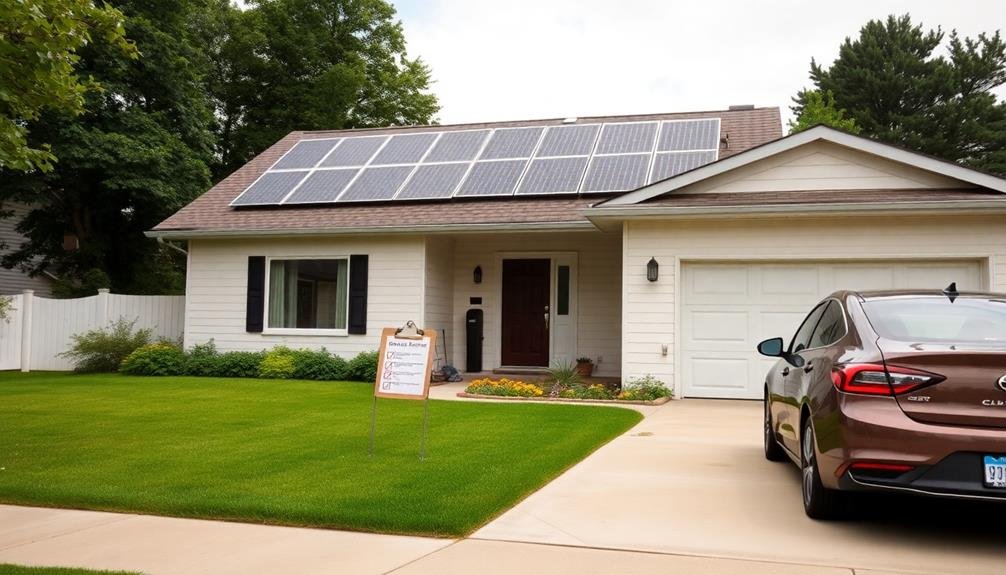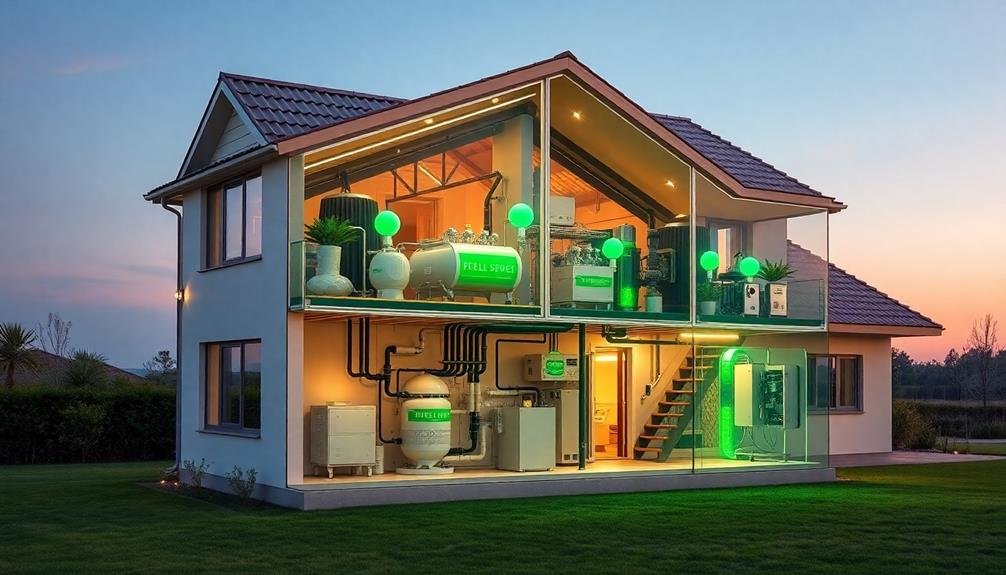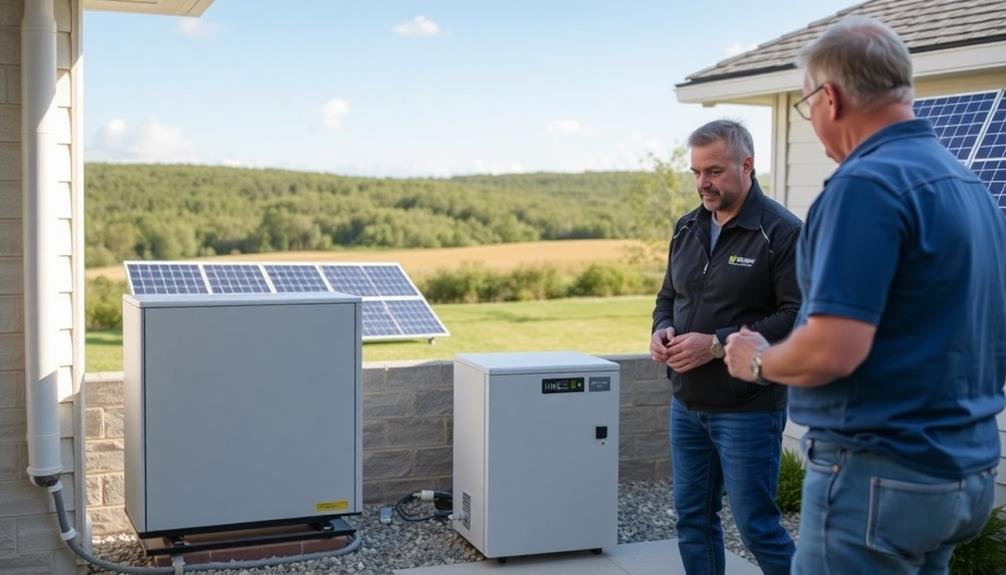To get home fuel cell grants, start by researching federal, state, and local programs. Check the Department of Energy's website, your state's energy office, and local utility companies for opportunities. Gather necessary documents like income verification, property ownership proof, and energy usage records. Complete the application accurately, ensuring all required information is included. Submit your application well before the deadline and follow up to confirm receipt. Be prepared for a lengthy review process and potential requests for additional information. Once approved, hire a qualified installer and maintain compliance with grant terms. Following these steps will set you on the path to securing financial support for your home fuel cell system.
Understanding Home Fuel Cell Technology

How do home fuel cells work? Home fuel cells are innovative devices that generate electricity through an electrochemical process. They combine hydrogen and oxygen to produce power, with water and heat as byproducts. Unlike traditional generators, fuel cells don't burn fuel, making them more efficient and environmentally friendly.
These systems typically use natural gas as their primary fuel source. The gas undergoes a reforming process to extract hydrogen, which then reacts with oxygen from the air in the fuel cell stack. This reaction creates an electric current that can power your home.
Home fuel cells come in various sizes, ranging from 1 to 5 kilowatts, capable of meeting most or all of your household's energy needs. They're designed to operate continuously, providing a reliable source of baseload power. When connected to the grid, they can supplement your energy supply or serve as a backup during outages.
The technology offers several benefits, including reduced energy costs, lower carbon emissions, and increased energy independence.
However, it's important to evaluate factors such as installation costs, maintenance requirements, and local regulations before investing in a home fuel cell system.
Types of Available Grants
When seeking grants for home fuel cells, you'll find two main categories to explore.
Federal grant programs offer nationwide opportunities, often through agencies like the Department of Energy.
Additionally, you'll want to check for state-specific incentives, as many states provide their own funding or tax credits to encourage residential fuel cell adoption.
Federal Grant Programs
Several federal grant programs are available to homeowners interested in fuel cell technology. The Department of Energy (DOE) offers the Residential Renewable Energy Tax Credit, which can cover up to 30% of your fuel cell system's cost.
To qualify, your system must have at least 0.5 kW of capacity and an electricity-only generation efficiency of 30% or higher.
The Rural Energy for America Program (REAP) provides grants and loan guarantees for renewable energy systems, including fuel cells, in rural areas. If you live in a qualifying location, you can apply for up to 25% of your project costs.
The State Energy Program (SEP) distributes federal funds to states for energy efficiency and renewable energy initiatives. Check with your state's energy office to see if they offer fuel cell grants through this program.
When applying for federal grants, keep these tips in mind:
- Read eligibility requirements carefully
- Gather all necessary documentation before applying
- Follow application instructions precisely
- Submit your application well before the deadline
State-Specific Incentives
In addition to federal programs, many states offer their own incentives for home fuel cell systems. These state-specific incentives can greatly reduce the cost of installing and operating a fuel cell in your home. You'll find that the types and amounts of grants vary widely from state to state.
Some states provide direct cash rebates for fuel cell installations. For example, California offers rebates up to $4,500 per kilowatt through its Self-Generation Incentive Program. Other states may offer tax credits or deductions. In New York, you can claim a tax credit of up to $5,000 for qualified fuel cell electric generating equipment.
Performance-based incentives are another option in some states. These programs pay you for the energy your fuel cell produces over time. Net metering policies, which allow you to sell excess electricity back to the grid, are also common in many states.
To find state-specific incentives, check your state's energy office website or use the Database of State Incentives for Renewables & Efficiency (DSIRE). Remember, these programs often have specific requirements and may change over time, so it's important to verify current information before applying.
Eligibility Requirements for Homeowners

Homeowners enthusiastic to secure fuel cell grants must meet specific eligibility criteria. These requirements vary depending on the program, but generally, you'll need to own and occupy the property where the fuel cell system will be installed. Your home should also be connected to the electrical grid, as most programs require grid-tied systems.
To qualify, you'll typically need to:
- Have a good credit score
- Provide proof of income
- Demonstrate your ability to maintain the system
- Show that your property is suitable for fuel cell installation
Before applying, verify your home meets energy efficiency standards. Many programs require an energy audit to identify areas for improvement. You may need to implement these upgrades before qualifying for a fuel cell grant.
Additionally, you'll need to work with a certified fuel cell installer. They'll help you determine if your property is suitable and assist with the application process.
Be prepared to provide detailed information about your energy usage and property specifications.
Researching Grant Programs
To find fuel cell grants for your home, start by exploring federal grant opportunities through the Department of Energy's website.
Next, check your state's energy office for specific incentive programs that may offer additional funding or tax credits.
Don't forget to contact your local utility company, as they often provide rebates for clean energy installations, including fuel cells.
Federal Grant Opportunities
For homeowners seeking financial assistance to install fuel cells, federal grant opportunities offer promising prospects. The U.S. Department of Energy (DOE) provides several programs that support residential fuel cell adoption. Start by visiting the DOE's Office of Energy Efficiency and Renewable Energy website to explore current funding opportunities.
One key program is the Residential Renewable Energy Tax Credit, which allows you to claim a percentage of your fuel cell system's cost on your federal taxes. Additionally, the DOE's State Energy Program offers grants to states, which may then distribute funds to individual homeowners for clean energy projects.
When applying for federal grants, keep these tips in mind:
- Read eligibility criteria carefully to verify you qualify
- Follow application instructions meticulously
- Provide detailed project plans and budget estimates
- Highlight the environmental and energy-saving benefits of your fuel cell system
Don't overlook other federal agencies that might offer relevant grants. The Environmental Protection Agency (EPA) and the Department of Housing and Urban Development (HUD) sometimes provide funding for clean energy initiatives in residential settings.
Remember to check their websites regularly for new opportunities and sign up for email alerts to stay informed about upcoming grant cycles.
State-Specific Incentive Programs
A treasure trove of state-specific incentive programs awaits homeowners looking to install fuel cells. To uncover these opportunities, start by visiting your state's energy office website. You'll often find a dedicated section for renewable energy incentives, including those for fuel cells.
Don't overlook your local utility company's website, as they may offer additional rebates or incentives for fuel cell installations.
Next, explore the Database of State Incentives for Renewables & Efficiency (DSIRE) website. This thorough resource allows you to search for incentives by state and technology type. Filter your search to focus on fuel cell-specific programs.
Contact your state's energy office directly to inquire about any recent or upcoming incentive programs that may not be listed online. They can provide up-to-date information on available grants, tax credits, and rebates.
Consider joining local renewable energy associations or attending green energy events in your area. These networks can be invaluable for staying informed about state-specific incentives and connecting with others who've successfully navigated the grant application process.
Local Utility Rebates
In addition to state-level incentives, local utility companies often offer their own rebates for fuel cell installations. These rebates can greatly reduce your out-of-pocket expenses and make adopting this clean energy technology more affordable.
To find utility rebates in your area, start by contacting your local electric or gas company directly. Ask about any programs they've for residential fuel cell systems or other renewable energy technologies.
Many utilities provide information about their rebate programs on their websites. Look for sections dedicated to "energy efficiency," "renewable energy," or "customer incentives." You'll often find detailed information about eligibility requirements, rebate amounts, and application processes.
Keep in mind that utility rebates may have specific conditions, such as:
- Installation must be performed by a certified professional
- System size limitations
- Energy efficiency requirements for your home
- Post-installation inspections
Don't forget to check with multiple utilities if you have options in your area. Some regions have separate electric and gas providers, each potentially offering different incentives.
Preparing Your Application

Several key steps are vital when preparing your application for home fuel cell grants. First, gather all necessary documentation, including proof of homeownership, recent energy bills, and a detailed project proposal. Next, research specific grant requirements and make certain your application aligns with the funding organization's goals.
When writing your application, focus on these important elements:
| Element | Description | Importance |
|---|---|---|
| Energy Savings | Projected reduction in energy consumption | High |
| Environmental Impact | Estimated decrease in carbon emissions | High |
| Cost-Benefit Analysis | Long-term financial benefits of the system | Medium |
Be sure to highlight your home's suitability for a fuel cell system, including available space and existing infrastructure. Provide a clear timeline for installation and implementation, demonstrating your commitment to the project.
Don't forget to proofread your application thoroughly, checking for accuracy and completeness. Consider having a professional review your submission to confirm it meets all requirements. Submit your application well before the deadline, allowing time for any necessary revisions or additional information requests. By following these steps, you'll greatly enhance your chances of securing a home fuel cell grant.
Gathering Necessary Documentation
To support your home fuel cell grant application, you'll need to gather essential documents.
Start by collecting income verification documents, such as tax returns or pay stubs.
Be sure to include proof of property ownership and recent energy usage records to demonstrate your current consumption patterns.
Income Verification Documents
When applying for home fuel cell grants, you'll need to provide accurate income verification documents. These documents prove your financial eligibility for the grant program. Most grant providers require recent pay stubs, tax returns, and bank statements to assess your income level.
Gather the following documents to verify your income:
- Last two years of federal tax returns
- Recent pay stubs (usually from the past 3 months)
- Bank statements from the past 6 months
- W-2 forms from the previous year
If you're self-employed, you may need to provide additional documentation, such as profit and loss statements or 1099 forms. Confirm all documents are up-to-date and accurately reflect your current financial situation.
Some grant programs may require specific forms or have unique income verification requirements, so check their guidelines carefully.
Be prepared to explain any discrepancies or unusual income patterns in your documents. If you have multiple sources of income, gather documentation for each source.
Keep copies of all submitted documents for your records. Providing complete and accurate income verification will help streamline your grant application process and increase your chances of approval.
Property Ownership Proof
After verifying your income, you'll need to prove you own the property where you plan to install the fuel cell. This step is vital to guarantee the grant is awarded to legitimate homeowners. You'll typically need to provide one or more of the following documents:
| Document Type | Description |
|---|---|
| Property Deed | Legal document showing ownership |
| Mortgage Statement | Recent statement from your lender |
| Property Tax Bill | Most recent tax bill for the property |
| Homeowners Insurance | Current policy document |
Contact your local county recorder's office to obtain a copy of your property deed if you don't have one. For mortgage statements or tax bills, check your online accounts or contact your lender or local tax assessor's office. Verify all documents are current and clearly show your name and property address.
If you're a recent homebuyer, you might need to provide additional documentation, such as your closing statement or title insurance policy. For properties held in trust or owned by multiple parties, you'll need to submit additional paperwork proving your authority to make improvements to the property.
Remember to redact any sensitive information, like account numbers or Social Security numbers, before submitting your documents. Keep copies of everything you send for your records.
Energy Usage Records
Typically, fuel cell grant applications require detailed energy usage records to assess your household's energy needs and potential savings. You'll need to gather at least 12 months of energy bills to provide a thorough overview of your consumption patterns. This information helps determine the appropriate size and type of fuel cell system for your home.
To collect your energy usage records, start by contacting your utility company. Many providers offer online portals where you can access and download your historical energy consumption data. If this option isn't available, request paper copies of your bills for the past year.
Verify you have both electricity and gas usage information, as fuel cells can potentially replace or supplement both energy sources.
When compiling your energy usage records, pay attention to:
- Monthly and seasonal consumption patterns
- Peak usage periods
- Total annual energy consumption
- Cost breakdown for electricity and gas
Once you've gathered this information, organize it in a clear, easy-to-read format. Consider creating a spreadsheet or graph to visually represent your energy usage over time. This presentation will make it easier for grant reviewers to assess your application and understand your household's energy needs.
Submitting Your Grant Application

Submitting your grant application is a critical step in securing funding for your home fuel cell project. You'll need to gather all the required documents and information before starting the submission process. Make certain you've completed the application form accurately, including your personal details, project description, and budget breakdown.
Double-check that you've attached all necessary supporting documents, such as energy usage records, property details, and quotes from fuel cell suppliers. Many grant programs require a professional assessment of your home's energy efficiency, so include this report if applicable.
Pay close attention to the submission deadline and method. Some programs accept online applications, while others require mailed-in documents. If submitting online, ensure you have a stable internet connection and allow enough time to upload all files. For mail-in applications, use certified mail or a tracked delivery service to confirm receipt.
Before hitting "submit" or sealing the envelope, review your entire application package for completeness and accuracy. Consider having a friend or family member proofread it for errors.
Navigating the Review Process
Once you've submitted your application, the review process begins. This phase typically takes several weeks to a few months, depending on the grant program and the volume of applications received. During this time, a panel of experts will evaluate your proposal based on predetermined criteria, such as technical feasibility, environmental impact, and potential energy savings.
To increase your chances of success, it's essential to understand the review process:
- Be patient and avoid contacting the grant administrators unless absolutely necessary
- Prepare for possible follow-up questions or requests for additional information
- Stay informed about any updates or changes to the review timeline
- Keep your project plans flexible in case partial funding is offered
If your application is approved, you'll receive a notification detailing the next steps, including the grant amount and any conditions attached to the funding.
Should your application be rejected, don't be discouraged. Many programs offer feedback on unsuccessful applications, which can be invaluable for future submissions. Use this information to refine your proposal and consider reapplying in the next grant cycle or exploring alternative funding options for your home fuel cell project.
Implementing Your Fuel Cell System

You've successfully secured your home fuel cell grant. Now it's time to implement your fuel cell system. Start by hiring a qualified installer who's experienced with residential fuel cell technology. They'll help you determine the best location for your system, considering factors like ventilation, accessibility, and proximity to your existing electrical setup.
Before installation begins, verify all necessary permits are in place. Your installer should handle this, but double-check to avoid any legal issues.
Once installation starts, expect the process to take several days to a week, depending on the complexity of your system. During installation, your team will connect the fuel cell to your home's electrical system and natural gas line. They'll also install a battery bank for energy storage and an inverter to convert DC power to AC.
After installation, thorough testing will be conducted to verify everything's functioning correctly.
Maintaining Compliance With Grant Terms
With your fuel cell system up and running, it's time to focus on maintaining compliance with your grant terms. Carefully review the documentation provided by the granting agency to understand your ongoing obligations. Most grants require periodic reporting on system performance, energy savings, and environmental impact. Set up a schedule to collect and analyze this data regularly.
Keep detailed records of all maintenance activities, repairs, and upgrades to your fuel cell system. These records may be necessary for audits or inspections. Stay current with any training or certification requirements specified in your grant agreement. Some programs mandate ongoing education to ascertain proper system operation and safety.
To maintain compliance, remember to:
- Submit all required reports on time
- Allow access for inspections when requested
- Notify the granting agency of any significant changes to your system
- Adhere to any usage or operational guidelines outlined in the agreement
If you're unsure about any compliance requirements, don't hesitate to contact your grant administrator for clarification. They can provide guidance on interpreting terms and meeting expectations.
Frequently Asked Questions
How Long Does a Home Fuel Cell System Typically Last?
You can expect your home fuel cell system to last between 10 to 20 years. With proper maintenance, it'll serve you well for a long time. However, some components might need replacement earlier, depending on usage and conditions.
Can I Install a Fuel Cell System in an Apartment?
You'll likely face challenges installing a fuel cell system in an apartment. It's not typically allowed due to space constraints, safety regulations, and landlord restrictions. Consider alternatives like portable fuel cells or energy-efficient appliances for your apartment instead.
Are There Any Safety Concerns With Home Fuel Cell Systems?
Yes, there are safety concerns with home fuel cells. You'll need to be aware of potential gas leaks, electrical hazards, and proper ventilation. It's essential to follow manufacturer guidelines and local regulations for safe installation and operation.
What Happens if My Grant Application Is Rejected?
If your grant application's rejected, don't lose hope. You can reapply after addressing any issues. Consider seeking feedback, improving your proposal, or exploring alternative funding options. There's often a chance to try again in future rounds.
How Much Noise Does a Home Fuel Cell System Produce?
You'll be pleased to know that home fuel cell systems are surprisingly quiet. They typically produce about 50-60 decibels of noise, which is comparable to a refrigerator. You'll hardly notice it's running in your home.
In Summary
You've now got the knowledge to pursue home fuel cell grants successfully. Remember to thoroughly research available programs, carefully prepare your application, and stay committed throughout the process. Once approved, implement your system diligently and maintain compliance with grant terms. By following this guide, you're well-equipped to take advantage of this eco-friendly technology and potentially reduce your energy costs. Don't hesitate to start your fuel cell journey today!





Leave a Reply